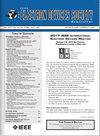电荷捕获层激活的常关Ga₂O₃MOSFET的陷阱分析:光子激发表征和TDDB
IF 2.4
3区 工程技术
Q3 ENGINEERING, ELECTRICAL & ELECTRONIC
引用次数: 0
摘要
采用电荷捕获层(CTL)技术实现了正常关闭的Ga2O3 MOSFET。栅极电介质由阻挡层(16 nm ${\mathrm {HfO}}_{\mathrm {x}} $ / 2 nm Al2O3)、CTL (5.76 nm Al:HfO ${_{\text {x}}}~1$:5)和隧穿势垒(2 nm Al2O3 / 2 nm ${\mathrm {HfO}}_{\mathrm {x}} $ / 2 nm Al2O3)组成。通过光子激发表征研究了CTL层的陷阱轮廓和栅极介电介质与Ga2O3通道的界面,得到了高度均匀的结果,表明了所提出方法的高质量和均匀性。此外,我们对无场板(NOFP)和有源连接场板(SFP)的器件进行了时间相关的介电击穿(TDDB)测试,以研究介电破坏机制,并为基于ctl的Ga2O3 mosfet的设计获得有价值的见解。本文章由计算机程序翻译,如有差异,请以英文原文为准。
Trap Analysis of Normally-Off Ga₂O₃ MOSFET Enabled by Charge Trapping Layer: Photon Stimulated Characterization and TDDB
A charge trapping layer (CTL) technique is incorporated to achieve a normally-off Ga2O3 MOSFET. The gate dielectric was engineered using a stack composed of a blocking layer (16 nm ${\mathrm { HfO}}_{\mathrm { x}}$ / 2 nm Al2O3), a CTL (5.76 nm Al:HfO ${_{\text {x}}}~1$ :5), and a tunneling barrier (2 nm Al2O3 / 2 nm ${\mathrm { HfO}}_{\mathrm { x}}$ / 2 nm Al2O3). The trap profile of the CTL layer and the interface of the gate dielectric and Ga2O3 channel are studied by photon-stimulated characterization, which yield highly uniform results, indicating the high quality and uniformity of the proposed method. Furthermore, we conducted a time-dependent dielectric breakdown (TDDB) test on devices both without a field plate (NOFP) and with a source-connected field plate (SFP) to investigate the dielectric failure mechanism and gain valuable insights for the design of CTL-based Ga2O3 MOSFETs.
求助全文
通过发布文献求助,成功后即可免费获取论文全文。
去求助
来源期刊

IEEE Journal of the Electron Devices Society
Biochemistry, Genetics and Molecular Biology-Biotechnology
CiteScore
5.20
自引率
4.30%
发文量
124
审稿时长
9 weeks
期刊介绍:
The IEEE Journal of the Electron Devices Society (J-EDS) is an open-access, fully electronic scientific journal publishing papers ranging from fundamental to applied research that are scientifically rigorous and relevant to electron devices. The J-EDS publishes original and significant contributions relating to the theory, modelling, design, performance, and reliability of electron and ion integrated circuit devices and interconnects, involving insulators, metals, organic materials, micro-plasmas, semiconductors, quantum-effect structures, vacuum devices, and emerging materials with applications in bioelectronics, biomedical electronics, computation, communications, displays, microelectromechanics, imaging, micro-actuators, nanodevices, optoelectronics, photovoltaics, power IC''s, and micro-sensors. Tutorial and review papers on these subjects are, also, published. And, occasionally special issues with a collection of papers on particular areas in more depth and breadth are, also, published. J-EDS publishes all papers that are judged to be technically valid and original.
 求助内容:
求助内容: 应助结果提醒方式:
应助结果提醒方式:


